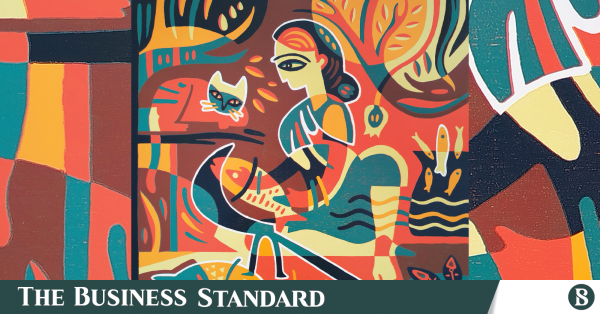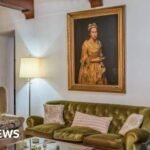
As you walk into the ‘Timber Tales’ exhibition at La Galerie, it seems like the room is divided into three parts. The different styles and contrasting colour palettes stand on their own. However, as you look closer at the stories behind these canvases, the connection that ties all the pieces together begins to reveal itself, which are the roots and personal experiences of each artist.
‘Timber Tales’, an exhibition on printmaking in Alliance Francaise de Dhaka, comprises the work of three artists: Rakib Alam Shanto, Abu Al Naeem, and Shakil Mridha. The exhibition is open to all and will close on 25 June.
‘Timber Tales’ is the creative brainchild of three artists who once shared the same classroom. Though they work in the same medium—printmaking—their artistic styles are strikingly different. This contrast inspired them to bring their unique visions together under one roof.
Having contrasting styles—folk, abstract, and realism—offers visitors a dynamic experience. However, the stories behind each piece are what bring the exhibition together.
Naeem focuses on abstract art, and many of his works are connected to his personal struggles. Pieces such as ‘Destruction’ and ‘Displacement’ convey heavy emotions through their etchings.
According to Naeem, his style is a direct reflection of his state of mind.
“When my emotions build up, I use that tension in my work. I take out all my anger through my art instead of bringing it into the world,” shared Naeem.
The combination of his emotions with the freedom of abstract art allows viewers to visibly see the artist’s emotions. For example, the piece ‘Displacement’ appears to be quite detailed, and even the artist admitted that it was one of his emotional pieces.
On the other hand, Mridha specialised in folk art, drawing on motifs and inspirations deeply rooted in our culture. Before introducing his art, however, Mridha first speaks about his upbringing. The artist was born and raised in Manikganj, and to this day, he holds onto the beauty of nature and rural life through his art.
Women appear as a recurring subject in many of his works. The artist often depicts them engaged in everyday activities or traditional crafts. In ‘Kaaru,’ a woman paints a tepa put, while in ‘Mach Kata,’ another is shown cutting fish with a traditional blade.
“If you want to focus on folk art, you have to recognise the women behind it. From what I’ve seen growing up, while the men went out to work, women were often left with the space and freedom to pursue their passions during their free time,” shared Mridha.
He continues, “They would make nakshi kantha and prepare pithas of different types, and men did not really have a hand in that.”
The artist uses saturated tones to reflect the vibrant colours that middle-aged women in villages wear. Furthermore, the artist shared that he is inspired by artists such as Picasso, which is one of the reasons behind the geometric shapes that make up each piece.
In contrast, Rakib Alam Shanto deals with realism in his art. With his roots in Puran Dhaka, many of his pieces are an ode to his childhood.
The artist works mostly with black and white, and yet can bring Puran Dhaka to life in his pieces.
“I wanted to work with one plate and save the complexity for my work itself instead,” shared Shanto.
Pieces such as ‘Old Dhaka Diaries: Boat Complexity of Buriganga 1’ capture both the chaos and charm of Puran Dhaka with the contrast of buildings and boats.
Shanto also shared that his works, such as ‘Old Dhaka Diaries: Relic of Borobari, The Grand Mansion of Prosannababu’ and ‘Boat Complexity of Buriganga’, are based on the heritage of Puran Dhaka, and that these were sites he grew up seeing.
TBS Picks
Roshuighor by Shakil Mridha
Medium: Woodcut on paper
The piece shows the connection between the land and people through the image of a kitchen. When conceptualising this piece, Mridha did not limit the kitchen to the interior of a home; instead, he included a pond where the fish are sourced from. The trail of fish in the picture leads the viewer’s eye to the pot, where it becomes sustenance for people.
Exhaustion by Abu Al Naeem
Medium: Woodcut on paper
The abstract piece depicts three bodies looking up in anguish. The artist shared that he created this during a time of turmoil, when he constantly felt like he was losing his balance in life. Naeem further shared that the three figures represent balance and thus are a reminder to stay steady, regardless of the hurdles.
Roots by Rakib Alam Shanto
Medium: Woodcut on paper
The massive 80 cm x 240 cm piece depicts the intricate roots of trees—what artist Shanto describes as the very source of a tree’s life. He also shares that it is the first thing people draw when they draw a tree. The canvas’s sheer scale enhances the work’s weight, drawing viewers closer to nature while evoking awe at how the chaotic tangle of roots serves as the foundation for life.












